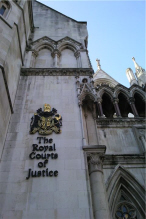When a house is (arguably) not a home
- Details
 When does the use of a dwelling house for commercial holiday lettings amount to a material change of use? Ian de Prez and Estelle Dehon explain the background to a key ruling by the Court of Appeal.
When does the use of a dwelling house for commercial holiday lettings amount to a material change of use? Ian de Prez and Estelle Dehon explain the background to a key ruling by the Court of Appeal.
The Supreme Court’s recent refusal of permission to appeal in the case of Moore v SSCLG and Suffolk Coastal District Council [2012] EWCA Civ 1202; [2013] JPL 192 means that Sullivan LJ’s judgment in the Court of Appeal can now be treated as a definitive reference point by local planning authorities considering when the use of a dwelling house for commercial holiday lettings or anything similar amounts to a material change of use requiring planning permission.
This case concerned St Audry’s House, which is located on a site which had previously been a small hospital with extensive grounds. In the late 1990s the whole site was redeveloped to provide some 200 dwellings with associated business, sports and social uses. St Audry's House is an eight-bedroom dwelling forming part of a listed building known as The Clubhouse. From 1999, when it first became available for occupation, until 2007 it was the home of a family with children. The current owner then acquired it and from 2008 onwards used it for commercial holiday lets. A room originally used for another purpose became a ninth bedroom.
The property was let for the majority of weekends during the year and sometimes also on weekdays. Groups came for reunions, parties and celebrations of one sort or another, including large groups (e.g. a yoga group of some 15 people and a cycling group of around 20). Stag and hen parties occurred in earlier years but were discouraged by the owner in response to complaints from neighbouring residents, who nonetheless continued to be very unhappy about the use.
Suffolk Coastal District Council issued a planning enforcement notice in November 2010 alleging the following breach of planning control “without planning permission the change of use of premises from the C3 dwelling to use as commercial leisure accommodation which does not fall within class C3 (a)-(c) and which therefore constitutes a sui generis use.”
In her appeal to the Secretary of State the owner argued that the alleged breach as framed was misconceived, practically unintelligible, and did not describe any recognised land use for planning purposes. However this appeal was unsuccessful, as was her appeal to the High Court under Section 289 of the 1990 Act heard by Frances Patterson QC sitting as a Deputy High Court judge.
Key principles of law
To go back to first principles, section 55 of the Town and Country Planning Act 1990 provides that planning permission is required for development which can take the form of either operational development i.e. building or engineering works or a material change of use. The Use Classes Order 1987 (as amended) (“UCO”) puts the more common uses of land into various broad categories. Section 55(2)(f) provides that a change to a different use falling within the same use class as the original use does not require planning permission. This may lead to changes of use that many people would judge to be quite different in character not requiring consent; for instance an accountant’s office becoming a betting shop, both uses falling within A2 (Financial and Professional Services). However, the converse is not true; case law established some years ago that the UCO is purely permissive, and so is irrelevant if no material change of use has occurred. In other words, the fact that a new use falls outside the defined parameters of the old use class, does not in itself cause it to be a material change of use (Rann v Secretary of State for the Environment (1979) 40 P&CR 113) A number of uses are not defined so as to fall within any of the classes in the UCO and are sui generis and a number of uses are defined as sui generis in article 3(6).
The permitted use of St Audry’s House is as a dwelling house. Class C3 of the current UCO defines this term as follows:-
“Use as a dwelling house whether or not as a sole or main residence by –
(a) a single person or by people to be regarded as forming a single household;
(b) not more than six residents living together as a single household where care is provided for residents;
c) not more than six residents living together as a single household when no care is provided to residents other than use within C4.” [C4 is the use class for Houses in Multiple Occupation].
There is no legislative definition of a material change of use. It is a question of fact and degree for the local planning authority, with which the courts will not interfere unless the conclusion reached by the local planning authority could not reasonably be made.
It must always be remembered that there may be a change of use which is not material and this distinction may be of particular significance in cases such as this one.
A decision maker may take into account off-site effects in terms of the impact on the amenity of neighbouring land users in determining whether a material change of use has occurred, as well as the alteration of the character of the land use on the site itself and of the surrounding area. [1]
Case law
Three cases fell to be considered in detail.
The earliest was Blackpool Borough Council Secretary of State for the Environment [1980] 40 P&CR 104. This concerned a four-bedroom townhouse in Blackpool whose owner had acquired it as an investment and ultimate retirement home, but also used it for holidays. Holidays were taken by himself and his family, but also friends or employees, and it was let out commercially when not required by them. Commercial lettings occurred for about 10 of the 18 weeks between June and the end of October. The premises were left empty for eight months in the year. The Council, anxious that this part of the town should be a residential area not overrun by holiday lettings, served an enforcement notice alleging an unauthorised material change of use from private dwelling house to use for holiday lettings on a commercial basis. The Divisional Court upheld the planning inspector’s decision to overturn the enforcement notice. Ackner LJ and Jupp J both emphasised that not every residential use of a dwelling house was necessarily use as a private dwelling house. They found, however, that the Inspector had been entitled to conclude as matter of fact that the character of the house in question had not changed. The house was not constantly being let in short holiday lettings and its character had not been changed by the succession of occupiers or by the fact that some were renting as single households.
In Gravesham Borough Council v Secretary of State for the Environment (1982) P&CR 142, McCulloch J in the High Court was required to consider the definition of a dwelling house. He held that a distinctive characteristic of a dwelling house was its ability to afford to those who used it the facilities required for day-to-day private domestic existence. Not every case was to be determined by having regard only or even primarily to the use to which building was in fact put, nor was the duration or frequency of the user always relevant, and in general little if anything turned on it.
And finally Moore v SSE and New Forest District Council [1999] 77 P&CR 114. This was a case relied on by the latest appellant, who argued that the Inspector in her appeal had paid it insufficient regard. The case concerned the outbuildings of a large country house, which has been turned into ten holiday units. The units were all self-contained, with no apparent connection between them, and each was supplied with the facilities necessary for daily life and a small, defined area of open air amenity space. The units were available to the public on short lets, including weekend and mid-week breaks, with the longest letting being for three or four months. An enforcement notice alleged a material change of use from a single dwelling house to mixed use of dwelling house with ten holiday lettings, all within the same planning unit. The Court of Appeal held that the change of use should have been defined as a change from a single dwelling house to 2 or more within section 55 (3) (a) of the 1990 Act. The self-contained units in this case did not cease to be used as 10 single dwelling houses because they were managed as a whole for the commercial purpose of holiday or other temporary lettings.
The Court of Appeal’s decision: A conundrum resolved?
Sullivan LJ warned against two opposite and equally erroneous extremes: that any holiday or commercial letting use will inevitably amount to a material change of use and the opposite that such a use can never in any circumstances amount to a material change of use.
At St Audry’s, the size of the house and hence its capacity, in particular when rooms were shared, combined with the close proximity of a large number of neighbours, some within the same building created an unusually problematic situation which was exacerbated by limited parking, a shared driveway and refuse bins, open grounds and the likelihood of unintentional trespass. The inspector had devoted 10 paragraphs of his decision letter to a consideration of the differences in land use which he summarised as the pattern of arrivals and departures, with associated traffic movements; the unlikelihood of occupation by family or household groups; the numbers of people constituting the visiting groups on many occasions; the likely frequency of party type activities, and the potential lack of consideration for occupiers.
To say that there was no material change of use would have been, as Sullivan LJ said, contrary to common sense.
This conclusion sits easily with the Blackpool case which left open the possibility that a more intensive commercial use of the house would have been a material change of use.
The judges were troubled by the fact that in the earlier Moore case, Nourse LJ concluded his judgment by saying that if the Secretary of State applied the correct test he could only have properly concluded that the 10 units were being used as 10 single dwelling houses. The court had followed Gravesham and had not been referred to Blackpool. However, this conclusion is explicable by the fact that the Secretary of State in the earlier Moore had put all his eggs in one basket by defending the challenge on a point of principle now identified as the other erroneous extreme to meet with disapproval in the instant case – that use as holiday accommodation was not in any circumstances use a single dwelling house within section 171B because it was not used as long-term home.
When the current case reached the Court of Appeal the argument had become quite narrowly focused. Mrs Moore's counsel conceded that he could not contend that the inspector had been bound to find in favour of his client as a matter of law. His principal argument was that the wording quoted above indicated that the Inspector had erred in law by making a comparison between the actual use of St Audry's House and use as a family dwelling house, thus putting the threshold for a materially unchanged use too low. The Court of Appeal decided that the decision letter read as a whole indicated that the Inspector had approached the matter correctly.
The second issue that occupied the Court of Appeal was the description of the use as commercial leisure accommodation in the notice. It was argued that this was too wide and unfair to the appellant. However the court concluded that he notice was not perfect, but no better alternative have been suggested.
Conclusion
The Suffolk Coastal case does not articulate any new principle, but it is significant in the clarification that it provides.
A multi-bedroom house used like St Audry’s, but located in a remote rural location may well have been treated differently. In that situation, it is a moot point as to whether there is a change of use which is not material because the adverse effects on any neighbours are much reduced, or whether there is a material change of use because of the alteration in the character of the land use, but it is not expedient to take enforcement action because no real harm is occurring. During argument in the Court of Appeal their Lordships expressed some unease about landowners being at the mercy of local planning authorities, hoping that they will make reasonable decisions on expediency but there is no reference to this in the judgement and it is suggested that this ought not to give rise to concern.
A two or three bedroom holiday cottage will exhibit some of the land use changes referred to by the Inspector in the instant case, but on a much smaller scale. People on holiday may be more likely to stay up late and to come and go in the evenings. They will not have the sense of attachment and responsibility of a permanent resident, or even of a second home owner. However, most neighbours will not be seriously aggrieved and might like the fact that the property was mostly unoccupied during the winter months.
It was always common ground that a dwelling house need not be occupied all the year round – a second home is still a home. A second home rarely used by its owner and sometimes put to commercial use will in many cases not cause a material change of use. A decision maker can appropriately refer to the wording of use class C3 which defines what is undoubtedly acceptable within planning law, as long as one is mindful that there may still be a range of residential and similar uses outside the express wording of the use class that will still not amount to a material change of use. The Court of Appeal endorsed the case law which places reliance on use as a “single household” as an indicator that there has not been a material change of use.
Thus, the character of the use of the house and the effect of that use on the character of the area remain important indicators of when a material change of use may have occurred, and when a house, arguably, is no longer a home.
Ian de Prez is a Solicitor Advocate at Suffolk Coastal District Council and Estelle Dehon is a barrister at Cornerstone Barristers. They can be contacted by email
Alun Alesbury (Cornerstone Barristers) represented the owner and Gwion Lewis (Landmark Chambers) the Secretary of State in these proceedings. We have also learned from the contributions of Zoe Leventhal (Landmark Chambers) and Edmund Robb (Prospect Law) who advised or represented the Secretary of State and the Council respectively at earlier stages of the litigation. However, any faults in this article are ours alone.
[1] See, for example, Panayi v Secretary of State for the Environment (1985) 50 P&CR 109, in which the Divisional Court held that effect on the residential character of the area, the resulting strain on welfare services, and the reduction in the stock of private accommodation available for renting were all relevant considerations in determining whether there had been a material change of use of a building that contained four self-contained flats to a hostel for homeless people, which had taken place without structural alterations.
Sponsored articles
Walker Morris supports Tower Hamlets Council in first known Remediation Contribution Order application issued by local authority
Unlocking legal talent
Lawyer (Planning and Regulatory)
Contracts Lawyer
Legal Director - Government and Public Sector
Locums
Poll







































